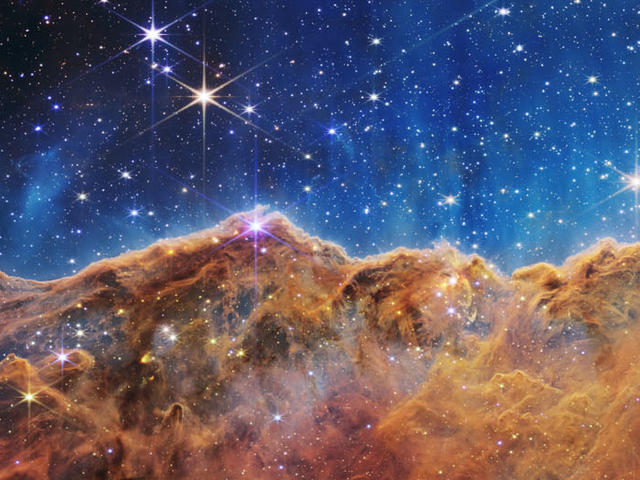The amazing information that light can carry
Some of us still remember the first images sent to us by the Hubble telescope, launched in 1990. Many of us were amazed to see that universe so clearly and so deeply, where the human eye had never reached. A scientific legacy that made our imagination fly to unknown worlds. Now, with the new Webb Space Telescope, we see how that wealth of discoveries and technological advances is becoming too small.
It is not just a matter of what our eyes can see, but how far our minds can excite our imagination.
We have a new sensation before us that is hard to understand because, basically, we are witnessing 'time' without realizing it. The images that reach us from this new human feat are created from the light that millions of stars have emitted millions of years ago and that only now reaches us.
The question is, are we looking into the past when we look into space?
It is very similar to what happens when we see a flash of lightning and a few seconds later hear the thunder it produces; we are 'hearing the past'. The same happens with light even though it travels much faster than sound. The light from the Moon takes about 1.3 seconds to reach the Earth, so we are seeing the Moon that was 1.3 seconds ago. If the Sun were to suddenly go out, we would not know until about 8 minutes later. When we see Saturn, we are seeing the Saturn that was an hour ago. With the naked eye we can see the star Betelgeuse and the light we see was emitted about 650 years ago, even before Columbus discovered America. The Orion nebula is about 1270 light years away and the light that reaches us today came out of Orion when the Middle Ages had just begun on Earth.
By looking to the farthest reaches of the universe with space telescopes like Webb we are looking back billions of years, so astronomers can see when galaxies were first forming. And by comparing those distant galaxies to more nearby ones, scientists can infer their evolution and 'shed light' on this symphony of creation within the Universe.
Webb's main mission is to detect infrared radiation, the invisible radiation emitted by distant stars, planets and gas clouds. Because of the unrivalled sensitivity of its telescope and instruments, Webb will be able to see the faintest light from deeper space. Using its NIRSpec and MIRI instruments (both built with Airbus participation), Webb will observe this infrared light from space in unprecedented detail, allowing it to go back in time 13.5 billion years to see the first galaxies formed after the Big Bang, as well as the formation of planetary systems in our own galaxy, the Milky Way.
Six months of commissioning activities
With the telescope optics and instruments aligned and the observatory near its final cryogenic temperature, the Webb space telescope team has been dedicated to the commissioning of the observatory’s four powerful science instruments: the Near-Infrared Camera (NIRCam), Near-Infrared Spectrometer (NIRSpec), Near-Infrared Imager and Slitless Spectrometer (NIRISS), and the Mid-Infrared Instrument (MIRI). Their mechanisms and detectors, including filter wheels, grating wheels, target acquisition capabilities and the NIRSpec micro-shutter assembly have been successfully operated.
But to operate any of the four instruments is not a straightforward endeavour, many factors have to be taken into account to get the best performance out of each one, such as:
Optical distortions
Calibrating optical distortion is required to precisely place the science targets on the instruments’ field of view. For example, to get the spectra of a hundred galaxies simultaneously using the NIRSpec micro-shutter assembly, the telescope must be pointed so that each galaxy is in the proper shutter, and there are a quarter of a million shutters!
Target acquisition for each instrument
For some observations, it is sufficient to point the telescope using the position of a guide star and know the location of the science target relative to that guide star. However, in time series observations, like measuring how an exoplanet’s atmosphere absorbs the stellar light during the hours it takes to pass in front of its star, require that the instrument send corrections to the telescope pointing control system to put the science target precisely in the correct location within the instrument’s field of view.
17 modes to unfold the new Universe
The observations planned for the first year of science with Webb ranges from our solar system to the most distant galaxies. There are 17 different instrument “modes” to be checked out before getting ready for the start of science this summer. Each mode has a set of observations and analysis that need to be verified. A representative example science target that will be observed in the first year of Webb science is selected for each mode. Each mode will be used for many targets, and most of Webb’s science targets will be observed with more than one instrument and/or mode. Each of the instrument modes have been fully commissioned.
Let’s get a bit scientific for a moment and take a closer look at the science modes of NIRSpec, Webb’s spectrograph workhorse that was built by Airbus.
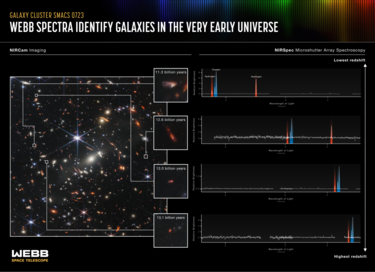
- NIRSpec multi-object spectroscopy. Although slitless spectroscopy gets spectra of all the objects in the field of view, it also allows the spectra of multiple objects to overlap each other, and the background light reduces the sensitivity. NIRSpec has a micro-shutter device with a quarter of a million tiny controllable shutters. Opening a shutter where there is an interesting object while keeping all other shutters closed allows scientists to get clean spectra of up to 100 sources at once. Example target: the Extended Groth Strip deep field.
- NIRSpec fixed slit spectroscopy. In addition to the micro-shutter array, NIRSpec also has a few fixed slits that provide the ultimate sensitivity for spectroscopy on individual targets. Example target: detecting light from a gravitational-wave source known as a kilonova.
- NIRSpec integral field unit spectroscopy. Integral field unit spectroscopy produces a spectrum over every pixel in a small area, instead of a single point, for a total of 900 spatial/spectral elements. This mode gives the most complete data on an individual target. Example target: a distant galaxy boosted by gravitational lensing.
- NIRSpec bright object time series. NIRSpec can obtain a time series spectroscopic observation of transiting exoplanets and other objects that change rapidly with time. Example target: following a hot super-Earth-size exoplanet for a full orbit to map the planet’s temperature.
The confirmation of NIRSpec’s multi-object spectroscopy mode marks the first time this capability has been verified for use from space. It will allow NIRSpec to characterize everything from the faintest objects in the universe to the formation of galaxies and star clusters.
NIRSpec is a truly European state-of-the-art technology spectrograph that will observe spectra of astrophysical and planetary objects at near infrared wavelengths. The NIRSpec Grating Wheel Assembly (GWA) uses diffraction gratings or a prism to separate the wavelengths of incoming light into a spectrum. Study of the intensity or brightness of light across the wavelengths can provide key diagnostic information about the nature of various objects across the universe – from extrasolar planets around distant stars, to faint galaxies at the edge of the universe, and objects in our own solar system.
NIRSpec is so sensitive that it could detect the infrared signature of a lit match on the Moon!
This amazing instrument was built for the European Space Agency (ESA) by a consortium of European companies led by Airbus Defence and Space with NASA’s Goddard Space Flight Center providing its detector and micro-shutter subsystems.
The new reality, an infrared Universe
The presentation of the ERO (Early Release Observations) images on July 12th (with NIRSpec EROs) concludes the Webb commissioning phase. This exhaustive and carefully planned six months long campaign (not to mention years of technology development and mission planning), has built up to the first images and data: a demonstration of Webb at its full power. The end of commissioning review (PLAR = Post Launch Assessment Review) is the kick-off to begin its science mission to unfold the infrared universe. The Airbus team has been supporting NASA in all the activities from the beginning.
A huge amount of work has been done in the past years to decide what Webb should first look at, organized in a collaborative effort between NASA, ESA, CSA, and the Space Telescope Science Institute (STScI) in Baltimore, home to Webb’s science and mission operations.
But the work goes on, because once Webb’s operations team of instrument scientists begin to acquire the spectral images, the production team will process it into images for astronomers and the public. This post-processing from raw telescope data to final, clean images that communicate scientific information about the universe can take weeks.
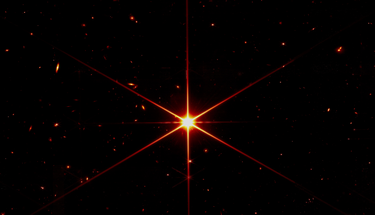
Early alignment imagery had already demonstrated the unprecedented sharpness of Webb’s infrared view. However, the new early release images are the first in full colour and the first to showcase Webb’s full science capabilities. In addition to imagery, Webb will also be capturing spectroscopic data, from which astronomers can obtain detailed information.
In fact, scientific teams from all over the world have already applied for time to use the telescope in its first year of observations. The 286 selected proposals address a wide variety of science areas and observations are carefully scheduled to make the most efficient use of the telescope’s time.
The early universe, the evolution of galaxies through time, the lifecycle of stars and the exoplanets composition are just a few of the realms that Webb will unveil, not to mention the unexpected discoveries astronomers can’t yet imagine.
So, get ready for a fascinating voyage.
We can all agree that space is dark (at least to the human eye), yet it is amazing how its infrared light unveils an ‘astronomical’ amount of information, much of it showing the distant past. If Webb is not a Time Machine, then what is?
pictures and infographics
Download
Documents
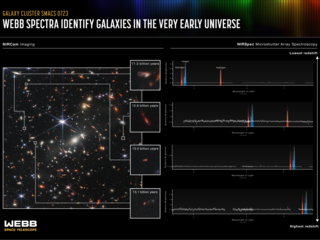
WEBBs first Deep Field and spectra by NIRSpec
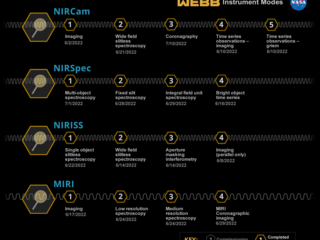
Webb Instrument Modes
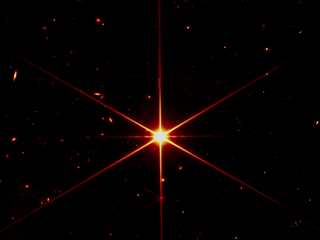
Early alignment image
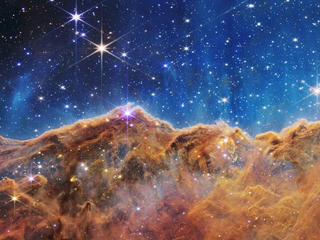
Carina Nebula taken by NIRCam
- Documents

WEBBs first Deep Field and spectra by NIRSpec

Webb Instrument Modes

Early alignment image

